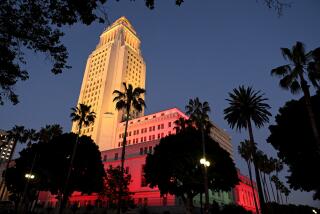Business-Friendly City Is the Problem, Not the Solution : A committee wants to ‘reform’ Los Angeles’ land-use development review and approval process. Greasing the skids for developers will only make our predicament worse.
- Share via
Mayor Richard Riordan and City Councilman Hal Bernson have a plan to “reform” the city’s land-use development review and approval process.
They want to create a “business friendly” environment by greasing the skids of City Hall. A committee of 20 of the city’s top developers, real estate attorneys, architects and land-use consultants has been named to achieve this. Homeowner leaders and community activists are noticeably absent from this panel.
The group is quietly holding meetings around the city and will issue a report shortly. The objective is to cut away what the group believes is useless red tape. For example, a Riordan news release said it took nine months and $10,000 to get approval for a single-family dwelling. In another instance it took a retail building seven months and $35,000 in unspecified costs to jump through the hoops.
We think that greasing the skids of City Hall in the name of economic relief for developers is a bad idea. The supposed crisis is nonexistent, and developers simply want to dismantle the present deliberative assessment of projects.
Proponents of one-stop permit shopping claim that businesses and residents are leaving Los Angeles in droves because there are too many obstacles to constructing a building.
The panel’s fundamental premise is flawed. Let’s look at the real reasons that business and residents find Los Angeles increasingly unattractive.
The Times reported in a May 18 article: “For the first time since the 1970s, the city of Los Angeles did not lead the state’s cities in population growth.” The article cites the Department of Finance statistics and describes a falloff in migration. According to demographers, this reduction is the direct result of a long California recession. People will move for jobs, and not many new jobs have been created in the last three years.
Los Angeles is in its present predicament not because it is too hard to get a building permit, but because it is too easy.
For decades, city administrations have given the store away. They have allowed developers to build inappropriate projects, many too big or in the wrong places. They have encouraged new business and an influx of residents without providing an adequate infrastructure. The result is a greatly reduced quality of life, traffic congestion, noise, diminished city services and a dilapidated sewage system.
Crime, burglaries and thefts have raised the cost of doing business. The character of the Los Angeles population has changed. This has resulted in inferior schools and a work force that can barely read or write, much less read a micrometer or interpret a spreadsheet. It is this continuing decline in the quality of the Los Angeles work force that has changed the city from a safe, manufacturing-based hometown to a world-class problem.
Some of the fault lies in a weak permitting and development review process. The Planning Commission regularly grants exceptions that are routinely approved by the City Council. They allow monstrosities, such as the Chalk Hall condominium project on Ventura Boulevard and canyons of four-story apartments towering over adjacent residents on Laurel Canyon. Businesses are allowed to open with inadequate parking, poor access and lack of ground transportation.
Tightened air quality regulations are pushing once-profitable businesses into the red. Overcrowding, crime and the flight of high-tech jobs are the real reasons that Los Angeles has become business-unfriendly. It is no longer a pleasant place to work or live.
Some of the most expensive and sought-after real estate lies in communities that have the world’s most rigorous, time-consuming and complex permitting processes. In New Orleans, you can’t change a stone or move one foot of wrought iron without getting city approval. Manhattan, Tokyo and Paris have rigorous, restrictive procedures.
Yes, it may take many months to review and permit a project. This is not bad. It gives neighbors time to react to environmentally destructive projects. Community groups can conduct independent investigations and open neighborhood dialogues before concrete trucks show up on a site. This scrutiny results in better projects that serve both developers and community needs.
A developer of the property at Ventura Boulevard and Hayvenhurst Avenue spent more than a year and a great deal of money trying to obtain an environmental review and permits. He threw in the towel before he could build an office building that would probably have remained half-empty. A second developer took over the site with a more acceptable project and was able to move through the process in record time and with minimal cost. A single-story supermarket, bookstore and attractively designed retail center are under construction.
Los Angeles residents should insist that quality, rather than quantity, of projects be stressed. Homeowner and community leaders must be well-represented on the Development Reform Committee panel. Working with developers, the group can create a truly business-friendly environment.
More to Read
Sign up for Essential California
The most important California stories and recommendations in your inbox every morning.
You may occasionally receive promotional content from the Los Angeles Times.










